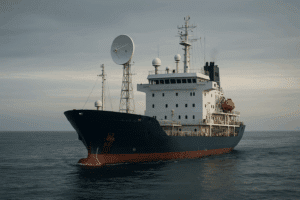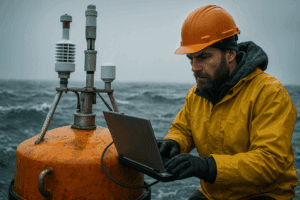In today’s world, several thousand vessels of all kinds are deployed and must be safely maintained and well managed. Before globalization and digitalization, there were only a few activities to ensure the shipping industry functioned smoothly. However, as the scale and complexity of international maritime operations grow, the task becomes increasingly difficult to manage.
This calls for a well-structured ship management team. Ship management is tasked with the responsibility of ensuring efficient ship operations. In the maritime industry, ship management is carried out by independent firms or owners. The ship management firm oversees the ships on behalf of the owner.
Ship Owners, Managers, and Operators
According to the broad definition, a shipowner is a natural or legal person who owns or rents a ship. A shipowner employs the captain and crew and is also liable for the ship’s operation. Thus, it is also the shipowner who wields all the power, aided by a hierarchy of subordinates.
It is certainly a difficult responsibility and job to run ships daily. The ship manager, who is responsible for this tremendous challenge, must manage and monitor ships in the most cost-effective way so that they save time and the ships under his supervision are ready for work wherever and whenever summoned. With a complete view of activities, the ship manager must also ensure the safety of the crew on board.
Ship operations include managing the crew, creating dry-docking requirements; overseeing dry docking, operational maintenance, and the preparation of insurance claims. Ship operations must also be financially vigilant which include costs, flexibly adapt to the constantly changing requirements of the maritime sector, ensure the ship has enough oil and fuel for the entire journey, and maintain close ties with customers, master sailors, and seafarers.
How to Track a Ship In Real-Time ?
Let us look at how a ships’ real-time tracker works, its details and features, its benefits for all players in the shipping sector but also its weaknesses…
Structure of Shipowning and Management Organizations
A Board of Directors, led by a Chairperson or President and a Managing Director, sits at the apex of any ship owning or operating corporate organization. It is their responsibility to define the general business strategy and the company’s future orientation.
The way these distinct operational tasks are handled, and particularly how the various duties are bundled together, must be delivered either internally or through contracting out to independent ship management businesses and services.
It is necessary to understand the numerous types of ships that are often used depending on the voyage — their use, the equipment system on board, and the criteria used by shipowners to decide the type and size of the ships to acquire. It is also critical to describe ship management in terms of the vessel, crew, owners, and people who employ the ship’s services, such as charterers, shippers, and passengers.
Credits: Maritime Studies South Africa
The Ship and Its Employment
To compare one vessel with another or to determine the feasibility of the vessel for a certain trade is vital to grasp the many methods used to address a vessel’s size and measurements.
Simply said, ships are typically seen as a liner. To be classified as a liner, the ship must operate on a scheduled basis between two specified regions, and its cargo must consist of many diverse shipments from various shippers, which are typically produced or semi-produced commodities. Rates of freight are often announced in a tariff and may change depending on the commodity.
The kind of vessel employed will be determined by the trading area, which may be a container ship, a Ro-Ro vessel, or a hybrid of the two types. General-purpose vessels are still employed in a small number of liner voyages, primarily in the Pacific. A Bill of Lading will often be the document that governs the contract of carriage between the parties.
Various measuring types are employed for various purposes.
Tonnage
This is the ship and cargo real weight.
Light Displacement Tonnage
This term refers to the vessel’s original weight when constructed, disregarding fuel, supplies, and crew. A vessel’s weight has minimal commercial value.
Total Displacement Tonnage
It is the weight sum of fuel, supplies, lubricants, human crew, etc, that enables a ship to sail. These are commonly referred to as “constants” and amount to approximately 3,000 tons on an average-sized vessel of about 40,000 DWAT. It is also used to describe the size of naval warships in military operations.
Deadweight cargo capacity (DWCC)
The maximum weight of cargo a vessel can carry.
Ship Management

After selecting the ship’s type, size, and trade, the owner decides how to operate and maintain the ship. The role of the ship manager is to ensure that the ship can responsibly and profitably carry out the duties specified by its owner.
Ship management is carried out in some situations by the shipowner’s organization, while in others, an external organization will be hired. In any case, the operations are essentially the same as before.
Ship Management Entails:
- Registering and documenting the ship as required by national and international authorities
- Crewing, victualling, stores, spare parts, maintenance, and repairs
- Training the crew
- Arranging insurance and handling claims and recoveries
- Appointing surveyors
- Ensuring safety of the crew and engineering systems
- Ensuring the ship follows the time schedule, and a variety of other tasks designed to keep the ship running smoothly
In essence, the ship management ensures the vessel is equipped for the voyage in every way possible.
Ship Registration
Ship registration plays a key role in the safety and security of maritime transit, as well as in the conservation and maintenance of the marine environment.
The general technique for identifying a ship’s nationality and controlling shipping is by its registration in a certain State. By associating a ship with a State, the ship registration system demonstrates that that State has the legal authority to safeguard that ship under international law.
The freedom of the high seas is a fundamental concept of public international law, as stated in the UN Convention on the Law of the Sea (Article 87). To balance this independence with the necessity to prevent unrest and corruption, international law has established a framework for maritime control.
Two Core Rules of this Framework:
The requirements to issue nationality by each State to ships for registration and granting the right to fly their flag (Article 91 of the UNCLOS).
The State must efficiently exercise its competence and control over ships flying its flag in administrative, technical, and social matters (article 94 of UNCLOS).
Article 91(1) of the UN Convention on the Law of the Sea recognizes each State’s authority to “establish the criteria for the issue of nationality and the right to fly its flag.”
How to Track a Ship In Real-Time ?
Let us look at how a ships’ real-time tracker works, its details and features, its benefits for all players in the shipping sector but also its weaknesses…
The Management of Risk
Risk management is a common synonym for insurance, that emphasizes the core premise of all insurance, risk-sharing, with most people willing to invest a minimal amount to help the minority. Typically, the insurance company or mutual association represents the majority, while the insured represents the minority.
The sorts of liabilities that need to be taken into consideration by ship management encompass:
- loss or damage to a ship (hull insurance)
- loss or damage caused by a ship (third party risk of protection and compensation)
- other additional hazards, including loss of employees and strikes
Overall, ship operation and management encompasses many different aspects, and with globalization and the increase of trade by sea vessels it is important ships are managed efficiently and effectively.
Frequently Asked Questions About: SHIP OPERATION AND MANAGEMENT
Ship operations include managing the crew, creating dry-docking requirements; overseeing dry docking, operational maintenance, and the preparation of insurance claims. Ship operations must also be financially vigilant which include costs, flexibly adapt to the constantly changing requirements of the maritime sector, ensure the ship has enough oil and fuel for the entire journey, and maintain close ties with customers, master sailors, and seafarers.
- Registering and documenting the ship as required by national and international authorities
- Crewing, victualling, stores, spare parts, maintenance, and repairs
- Training the crew
- Arranging insurance and handling claims and recoveries
- Appointing surveyors
- Ensuring safety of the crew and engineering systems
- Ensuring the ship follows the time schedule, and a variety of other tasks designed to keep the ship running smoothly
Types of shipping include: bulk carriers to transport grain, ore, wood ships and other materials/products down into a hold, general cargo ships who carry loose-packaged cargo, consisting of goods, unpacked or packed, cargo container ships, tankers, and roro ships.
Safe ship operations are measures taken to ensure safety onboard and safety with environmental surroundings.


